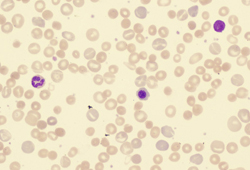Resumen
Definición
Anamnesis y examen
Principales factores de diagnóstico
- presencia de factores de riesgo
- palidez
- ictericia
Otros factores de diagnóstico
- fatiga
- disnea
- mareos
- esplenomegalia
- infecciones activas
- orina oscura episódica (hemoglobinuria)
- provocada por exposición al frío
Factores de riesgo
- trastornos autoinmunitarios
- trastornos linfoproliferativos
- válvula cardíaca protésica
- cuya familia originalmente proviene del Mediterráneo, Oriente Medio, África o el sudeste asiático
- antecedentes familiares de hemoglobinopatía o defectos de la membrana de los eritrocitos
- hemoglobinuria paroxística nocturna
- exposición reciente a cefalosporinas, penicilinas, derivados de la quinina o antiinflamatorios no esteroideos
- exposición reciente a naftaleno o a habas
- lesión térmica
- esfuerzo fuera de lo común
- exposición reciente a nitritos, dapsona, ribavirina o fenazopiridina
- ingesta reciente de paraquat
- malaria
- babesiosis
- bartonelosis
- leishmaniasis
- infección por Clostridium perfringens
- infección por Haemophilus influenzae tipo B
- hepatopatía
Pruebas diagnósticas
Primeras pruebas diagnósticas para solicitar
- hemograma completo (HC)
- concentración de hemoglobina corpuscular media (CHCM)
- recuento de reticulocitos
- frotis de sangre periférica
- bilirrubina no conjugada (indirecta)
- lactato deshidrogenasa (LDH)
- haptoglobina
- análisis de orina
Pruebas diagnósticas que deben considerarse
- prueba de antiglobulina directa (Coombs)
- creatinina, urea
- pruebas de función hepática (PFH)
- anticuerpos de Donath-Landsteiner
- electroforesis de hemoglobina (Hb)
- citometría de flujo para CD55/CD59
- prueba de mancha fluorescente y espectrofotometría de glucosa-6-fosfato deshidrogenasa (G6PD)
- anticuerpo antinuclear
Algoritmo de tratamiento
adquirida: prueba de antiglobulina directa (test de Coombs) positiva
adquirida: prueba de antiglobulina directa (test de Coombs) negativa
trastornos hereditarios
Colaboradores
Autores
John Densmore, MD, PhD
Associate Professor of Clinical Medicine
Department of Medicine
University of Virginia
Charlottesville
VA
Divulgaciones
JD declares that he has no competing interests.
Agradecimientos
Dr John Densmore would like to gratefully acknowledge Dr Michelle Loch, a previous contributor to this monograph. ML declares that she has no competing interests.
Revisores por pares
Pasquale Niscola, MD
Hematology Unit
Sant'Eugenio Hospital
Rome
Italy
Divulgaciones
PN declares that he has no competing interests.
Alan Lichtin, MD
Staff Hematologist-Oncologist
Hematologic Oncology and Blood Disorders
Cleveland Clinic
Associate Professor
Internal Medicine
Cleveland Clinic Lerner College of Medicine
Cleveland
OH
Divulgaciones
AL declares that he has no competing interests.
Agradecimiento de los revisores por pares
Los temas de BMJ Best Practice se actualizan de forma continua de acuerdo con los desarrollos en la evidencia y en las guías. Los revisores por pares listados aquí han revisado el contenido al menos una vez durante la historia del tema.
Divulgaciones
Las afiliaciones y divulgaciones de los revisores por pares se refieren al momento de la revisión.
Referencias
Artículos principales
Go RS, Winters JL, Kay NE. How I treat autoimmune hemolytic anemia. Blood. 2017 Jun 1;129(22):2971-9 Resumen
Hill QA, Stamps R, Massey E, et al. The diagnosis and management of primary autoimmune haemolytic anaemia. Br J Haematol. 2017 Feb;176(3):395-411.Texto completo Resumen
Hill QA, Stamps R, Massey E, et al. Guidelines on the management of drug-induced immune and secondary autoimmune, haemolytic anaemia. Br J Haematol. 2017 Apr;177(2):208-20.Texto completo Resumen
Artículos de referencia
Una lista completa de las fuentes a las que se hace referencia en este tema está disponible para los usuarios con acceso a todo BMJ Best Practice.

Diferenciales
- Anemia causada por pérdida de sangre
- Anemia por subproducción
- Reacción a la transfusión
Más DiferencialesGuías de práctica clínica
- Guidelines for the monitoring and management of iron overload in patients with haemoglobinopathies and rare anaemias
- Diagnosis and treatment of autoimmune hemolytic anemia in adults
Más Guías de práctica clínicaVideos
Demostración animada de venopunción y flebotomía
Demostración animada de la canulación venosa periférica
Más vídeosInicie sesión o suscríbase para acceder a todo el BMJ Best Practice
El uso de este contenido está sujeto a nuestra cláusula de exención de responsabilidad